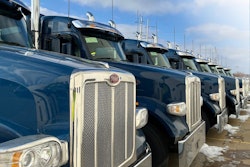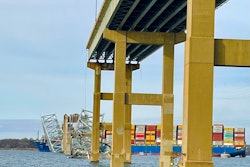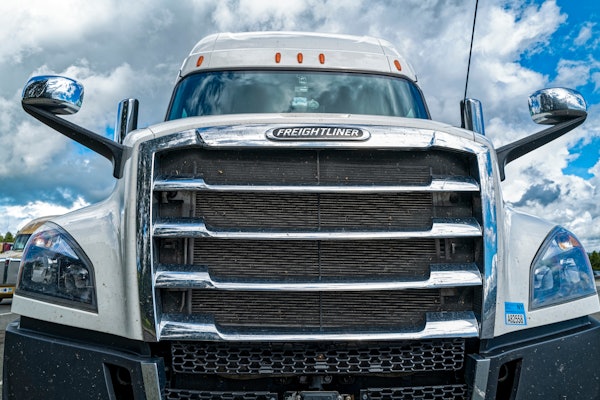Fleets, especially in the current market, are faced with numerous challenges to be more efficient, meet sustainability goals and improve the safety and wellbeing of their drivers.
Telematics provider Teletrac Navman each year conducts a Telematics Survey among fleets to gauge the industry’s efforts in those areas.
Joining us this week is Teletrac Navman’s chief marketing officer, Carlos Caponera, who discusses the results of the 2024 Telematics Survey and what it means for fleets and trucking.
Contents of this video
00:00 10-44 intro
00:30 Sustainability goals and driver safety and wellbeing
01:55 Driver safety
02:28 Sustainability and net zero initiatives
05:01 Video telematics
06:52 Zero emissions transition
08:57 Optimize operations and improve bottom line
11:01 Benefits of telematics
Jason Cannon:
CCJ's 10-44 is brought to you by Chevron Delo Heavy-Duty Diesel Engine Oil. Now there's even more reasons to choose Delo.
Matt Cole:
What are fleets doing to improve operational efficiency, driver safety, and sustainability efforts?
Jason Cannon:
You're watching CCJ's 10-44, a weekly webisode that brings you the latest trucking industry news and updates from the editors of CCJ. Don't forget to subscribe and hit the bell for notifications so you'll never miss an installment of 10-44.
Hey everybody. Welcome back. I'm Jason Cannon and your co-host on the other side is Matt Cole. Fleets, especially in the current market, are faced with numerous challenges to be more efficient, meet sustainability goals, and improve safety and well-being of all their drivers.
Matt Cole:
Telematics provider, TeleTrac Navman, each year conducts a Telematics survey among fleets to gauge the industry's efforts in those areas. Joining us this week is TeleTrac Navman's Chief Marketing Officer Carlos Caponera who discusses the results of the 2024 Telematics survey and what it means for fleets and trucking.
Carlos Caponera:
Teletrac Navman's been around for about over 30 years now. We do GPS tracking telematics around the globe and we have offices around the US, Australia, Zealand, UK, and Mexico and we provide fleet management services for medium, small, and large fleets as well as construction, we work in the construction industry, government, and general services. We've been writing the Telematics survey now for about seven, eight years. We paused during COVID naturally and we conduct it as a global survey. So we go out and reach out to fleet managers, fleet operators, around the globe, mostly in the areas that we play in and the regions we play in and we conduct a general survey, a digital survey, get the results, and we take the results and basically express out them in the report on an annual basis.
Jason Cannon:
Driver safety initiatives, a push toward cleaner emissions, and the impact of telematics on fleet efficiencies were the three key areas of this year's survey.
Carlos Caponera:
Well we've seen a big push around safety programs. So we're curious to see how that's affecting the US market in particular. We've seen a lot of growth in the video telematic space and safety services, driver safety behavior. Teletrac Navman has these products available and so we wanted to see what are the next steps or what's kind of the next phase in safety? And we're also looking at the advent of sustainability and the net-zero initiatives that the US government's taking place and global governments are taking place to see how that's affecting fleet managers and fleet operators and we got some surprising feedback from the survey in terms of sustainability where fleet managers are in their evolution towards net-zero and also we also wanted to take a look at how overall telematics is helping fleets become more in their day-to-day operations. So really looking at fleet efficiency, safety and well-being, as well as sustainability as part of the global survey.
Matt Cole:
A lot of truck drivers are hesitant about video telematics and maybe for good reason, with early adopters commonly using cameras as a gotcha tool when things go wrong. Carlos explains how that's changing after a word from 10-44 sponsor Chevron Lubricants.
Speaker 4:
These past few years have been less than easy. We've encountered challenges we never imagined we'd ever have to deal with. From makeshift home offices and video meetings to global supply chain uncertainty, price instability, market disruptions, and everything in between. Delivering the level of services and products our customers had come to expect was difficult for all of us. We can't change what's behind us, but we can definitely learn from it. We can adapt, evolve, and take steps to reset our thinking, adapt our strategies, and restore your trust in us to better meet your needs, now and in the future. That change begins today.
Today we break with convention and introduce a rebalanced line of Delo heavy-duty engine oils. We've reduced our product line from four categories to two. Consolidated and simplified, this lineup removes complexity from the manufacturing processes, enhancing price stability, and supply chain reliability so you can trust you will have the premium products you need to keep your business always moving forward. Our break with convention optimizes the Delo lineup to allow you to provide your customers with the best synthetic blend and synthetic heavy-duty engine oils in the market, fully available at prices you can rely on. It's your assurance that you'll be well positioned to be their trusted source for proven engine protection that keeps equipment on the job, giving your customers even more reasons to choose Delo.
Carlos Caponera:
On the safety side, we're seeing a major, major push around driver appreciation. Originally, a lot of fleet managers thought that video telematics would be more of a big brother type of a device that's watching and observing the drivers on the road, but it's evolved into more of a support training tool. One of the major drivers of improved driving behavior is appreciation. So we've seen things all the way out to gamification of driver safety and driver scoring. A lot of training goes in place. We saw 63% of the drivers, however, recognize mental health as being kind of the mainstream. Rising cost of living and that's really happened in terms of where the economy's at today in the US market. It's leading to a lot of stress in terms of what the drivers face day-to-day. And therefore, the safety and well-being is one of the top and center most important factors that managers this year were giving feedback through the survey.
So through the adoption of video telematics, they're able to help coach and train positive reinforcement more than anything. I think that the original approach was negative reinforcement and kind of slap in the hands of drivers that we're not being irresponsible out on the road, but like I said, it's evolved greatly with the use of technology. It's really becoming a supportive type process, being able to see the results too are there. So in the survey we saw 73% of those surveyed recognized there are fewer accidents on the road since adopting either telematics or video telematics and training combination, which has helped bring safer roads to those out there on their day-to-day routes.
Jason Cannon:
Sustainability is a hot topic in trucking with fleets setting goals to reduce emissions down the road. Carlos says he was surprised to hear from fleets in the survey about their projected timelines for a zero emissions transition.
Carlos Caponera:
One of the big surprises kind of came to light, let's say too, adoption is happening faster than what we expected internally. 79% of those surveyed expected more than half their fleets to be using alternative fuel systems in the next five years, which is crucial. That's a big step for a lot of the markets in particularly the US market. The US market, we're seeing a lot more advancement in electric vehicles for short haul and deliveries and we see that every day. The FedEx truck outside of our building is electric, comes by, and that change happened overnight. All of the sudden we're seeing electric vehicles dropping off our Amazon deliveries, et cetera. And that was one where we're seeing it shift faster than what we expected and I think it's going to accelerate even further as we see long haul vehicles now start rolling off the assembly line with EV transmissions, right?
We see what Tesla's doing with their semis. Nikola's hit a couple of speed bumps, but they're also developing different fuel systems for large semis. So that's one surprising part of the survey. We expected it to take longer, but it's almost upon us so we just have to be ready. And then the other one is kind of the government expectations, right? In our survey, one of the leading headlines here is a lot of the US participants in the survey do not believe the government's going to move as fast in terms of their energy mandates, which we internally believe they will. TeleTrac Navman and our parent company Volunteer is working closely to develop electrification grids across the US and with that, we do see a lot of government support and a lot of their mandates we believe are going to come through to fruition. I know a lot of fleet managers don't see it that way, but I do believe it will happen.
Matt Cole:
In terms of efficiency, the survey showed that more fleets are utilizing Telematics to help optimize their operations and improve their bottom line.
Carlos Caponera:
Yeah. The telecost of ownership is always is front and center in a lot of fleet managers, operators, and owner-operators especially, right? The rising cost of fuel, it's been a long-running stat within our survey that that's the top most critical issue and challenge facing ownership nowadays. The one thing we have seen is a large sum of our surveyors have adopted Telematic solutions. It helps them reduce idle time, become more efficient drivers in terms of how they maintain their vehicles. I know that being able to maintain your vehicle and keep up with maintenance cycles helps extend the lifetime of your vehicle.
So a lot of those factors really counter or countermeasures to the rising costs of fuel and insurance, etc. So having a fully formed package, in our opinion, a Telematics package that handles your maintenance, your route planning, your video safety and monitoring, and compliance, having that full package can really reduce your overhead, dropping your insurance costs, retaining your drivers within your fleet, improving your overall satisfaction in your end customers because your vehicles are getting there on time and there are no delays because your vehicle's not broken down on the road. Your driver got maybe into an accident, etc. So there's a lot of advantages around the efficiency side.
We're also starting to see more and more of our customers take on higher AI, being able to now bring in technology to help them make these decisions, the critical pre-decisions on a day-to-day you have to make as a fleet manager. So we're hoping that the technology will also be adopted at a higher level. Not just on the reporting side where people are just looking at day-to-Day reports that show what happened yesterday, but taking on the technology that helps them make the decisions here and now and helps them plan for the next week or the next cycles as their vehicles come in and out of their yards.
Jason Cannon:
Finally, Carlos offers key takeaways from the new Telematics survey report that fleets can use to their benefit.
Carlos Caponera:
For those that are reading the report, I think three things stand clear to me. If you're not using Telematics at this point or you're not using these technology tools, you need to have them as part of your wheelhouse in terms of developing your business and becoming more efficient. Got to be competitive in that space. Around the safety of your fleet and the wellbeing, there's a lot of tools out there that help driver coaching, training, et cetera. I think that's a must have. Not only is it going to reduce the cost of your fleet in terms of insurance costs and operating costs, it's also going to get your drivers in a better position so they're not always on the defensive and you're helping reinforce positive driver behavior.
And finally, the sustainability and net-zero fleets will be here soon enough. So starting to learn about the technologies, starting to understand the challenges in adoption, and really understand the best route for you as the owner of your fleet and vehicles in the future expansion of your company, you really have to take a keen eye and learn more about it. There's a lot of routes to be taking, there's a lot of possibilities out there, and there's just not one fit for purpose for one technology fits everyone. You really have to educate yourself in terms of learning what's best for the future of your company and the future of your business.
Jason Cannon:
That's it for this week's 10-44. You can read more on ccjdigital.com and while you're there, sign up for our newsletter and stay up to date on the latest in trucking industry news and trends. If you have any questions or feedback, please let us know in the comments below. Don't forget to subscribe and hit the bell for notifications so you can catch us again next week.










